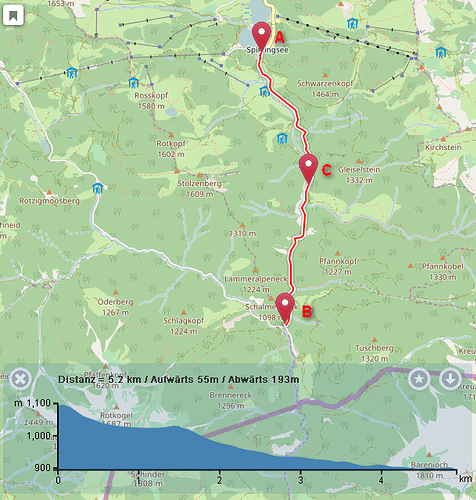I’m afraid this is not what I observe:
First route, A to B:
2016-09-27 08:55:20,978 [qtp1508269304-15] INFO com.graphhopper.http.GHBaseServlet - point=47.660647256808595,11.886005401611326&point=47.6205125920641,11.891155242919922&instructions=true&type=json&key=undefined&weighting=shortest&vehicle=foot 127.0.0.1 de_DE Mozilla/5.0 (Windows NT 6.1; WOW64; rv:49.0) Gecko/20100101 Firefox/49.0 [47.660647256808595,11.886005401611326, 47.6205125920641,11.891155242919922], took:0.009775207, , shortest, foot, alternatives: 1, distance0: 5174.22888327678, time0: 62min, points0: 120, debugInfo: idLookup:0.001906773s; , algoInit:2.17955E-4s, dijkstrabiCH-routing:0.005917761s, extract time:1.7553E-4;, algoInit:2.17955E-4s, dijkstrabiCH-routing:0.005917761s, extract time:1.7553E-4, simplify (132->120)
Second route, A to B to C: (C is on the route between A and B):
2016-09-27 08:55:51,361 [qtp1508269304-14] INFO com.graphhopper.http.GHBaseServlet - point=47.660647256808595,11.886005401611326&point=47.64110425422311,11.896305084228516&point=47.6205125920641,11.891155242919922&instructions=true&type=json&key=undefined&weighting=shortest&vehicle=foot 127.0.0.1 de_DE Mozilla/5.0 (Windows NT 6.1; WOW64; rv:49.0) Gecko/20100101 Firefox/49.0 [47.660647256808595,11.886005401611326, 47.64110425422311,11.896305084228516, 47.6205125920641,11.891155242919922], took:0.005373121, , shortest, foot, alternatives: 1, distance0: 5174.226807326266, time0: 62min, points0: 122, debugInfo: idLookup:0.001483086s; , algoInit:1.95731E-4s, dijkstrabiCH-routing:7.00446E-4s, extract time:7.8652E-5;, algoInit:1.74575E-4s, dijkstrabiCH-routing:5.9907E-4s, extract time:7.8786E-5;, algoInit:1.95731E-4s, dijkstrabiCH-routing:7.00446E-4s, extract time:7.8652E-5;, algoInit:1.74575E-4s, dijkstrabiCH-routing:5.9907E-4s, extract time:7.8786E-5, simplify (134->122)
-> the distance is the same for both routes, expectation would be that the distance of the leg from B “back to” C would be added to that of the distance between A and B (as well as the resulting point list etc.)


 right - I should have seen that, so it’s the leaflet plugin (or my usage of it) which is the culprit. sorry and thanks for the eye opener!
right - I should have seen that, so it’s the leaflet plugin (or my usage of it) which is the culprit. sorry and thanks for the eye opener!